Probing flow-induced crystallization of polymer with in-situ synchrotron radiation X-ray microdiffraction
Flow-induced crystallization (FIC) is of vital importance to polymer physics and industry. Attention has been focused on flow-induced precursors in recent years, which is the essential flavor to construct the molecular mechanism of FIC. The Softmatter group from National Synchrotron Radiation Lab of USTC combined the home-made fiber pulling device with synchrotron radiation X-ray microdiffraction (SR-XRD). X-ray diffraction patterns in spot area of 4.9 × 5.3 µm2 were obtained by scanning proximities around the fiber. The intrinsic advantage due to the high brilliant beam, SR-XRD with high temporal and spatial resolution enhances the detecting sensitivity significantly, which provides direct evidences for the existence of non-crystalline precursor. [Macromolecules 2014, 47, 4408 – 441]
Combining home-made mini tensile device and SR-XRD, the group obtains the 2D distributions of crystallinity around the crack tip of stretched natural rubbers, which exhibit an unexpected soft-hard double network structure (see the figure). The soft-hard double network structure avoids the stress concentration and enhances the crack resistance dramatically. The fracture energy enhancement factor obtained by utilizing the double network model indicates a theoretical enhancement of toughness by 3 orders at the strain of 5.5. Upon stretching, the micro-scale double network structures concomitant with conformational transformation at molecular level and crystallization in nano-scale construct hierarchical structure, which accounts for the remarkable mechanical performance of natural rubber. [Scientific Reports 2014, 4, 7502]

(a) The photomicrograph of natural rubber film at ε=0 and ε=3.5, respectively; here a coordinate system is indicated by the arrows with X axis perpendicular to and Y axis parallel with the stretching direction. The zero point is located on the edge of the crack tip; The 2D local crystallinity distributions in the vicinity of the crack tip ((b)-(c)) and far away from the crack tip ((e)-(h)) at different strains.
3.jpg
Back

